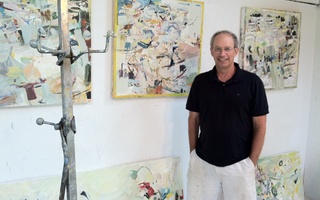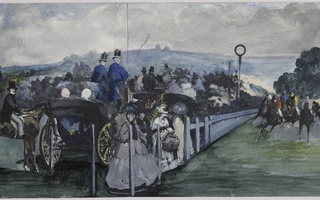{shortcode-66f8f0bbe07646d0ad0edb5c08bca846b623aa55}“Capture the balance of this pose,” Heddi Siebel says as she walks around the room. “Get the back, get the weight.”
Students stand around the model, Callista Womick, in a semicircle, facing easels with charcoal in hand. They draw in silence, with eyes flickering back and forth between their page and Womick. Some of their drawings will be quick, completed in 30 seconds, and others will be developed over the course of an hour.
Hired by the Office for the Arts at Harvard, Siebel teaches this weekly class in Currier Treehouse, which is open to all Harvard students. With multiple degrees in printmaking and years of artistic teaching experience at several universities, Siebel is now in her third year teaching “Figure Drawing,” a class that has run for over 30 years. She welcomes students with varying degrees of drawing experience, and emphasizes the empathy evoked by figure drawing, particularly through studying the nude model.
Izzi Steinhaus ’18, an Applied Math concentrator, had no formal artistic background prior to college but has taken two visual arts classes through the Visual and Environmental Studies department. “These classes deeply challenged me to feel confident getting out of my comfort zone,” she says. “I had wanted to take a drawing class for a long time, and I had no experience with figure drawing, so this felt like a perfect opportunity to challenge myself and learn a lot.”
This desire to be challenged is essential to the class, according to Siebal. “I don’t want it to be competitive. It’s not art school,” she says. “But I do want it to be taken seriously. I throw the challenges out, and they can accept them or not.”
The class, then, is less about skill and more about observation. “I think it’s so vital and important for one human to be studying, looking, and perceiving another human because it eventually creates empathy,” Siebel says. “You’ll start to understand your own vulnerabilities by studying those of the model.”
Siebel believes that the students have more power because they are clothed, as opposed to the model. She often has her students pose with the model, one at a time, to understand the feeling of being in front of others and the vulnerability that comes with it. “I want them to bring that energy into their own drawing,” Seibel says.
She says the model’s nudity does not imply sexual undertones, however. “It’s a cliché that the relationship between the artist and model is sexual just because the model isn’t wearing clothes,” Siebal says. “You don’t want to reduce it to something that’s just about sexuality.”
According to Steinhaus, Siebel ensures that the class is always respectful to everyone in the room. For example, the dialogue between the students, instructor, and model during each session is limited and professional. To ensure the model is comfortable, Siebel asks, “I’m thinking about making this pose an hour. Do you think you can handle it?”
Because they have worked with each other for years, she and Womick sometimes joke during the studio sessions. When Womick is in a particularly difficult position for a 30-second pose, for example, Siebel says, “Want to hold that for an hour?”
“I wish I could,” Womick says with a laugh.
Womick, an artist herself, has been a professional model since 2014. Different models usually come in every week—“We have male figures, female figures, heavyset figures, thin figures,” Siebel says—but Womick is here for three consecutive weeks while students work on a series of three drawings, unified through medium, theme, or concept of choice.
Siebel sees drawing as having particular value in a fast-paced culture. “One of the biggest problems with contemporary culture is that we look so fast at things now that we don’t really see them,” Seibel says. Drawing, on the other hand, is about slowing everything down.
“We need more arts. More observation,” she says. “The more that you look and the more that you see and the more you connect with your surroundings, you appreciate things and people more.”
— Staff writer Kaylee S. Kim can be reached at kaylee.kim@thecrimson.com.
Read more in Arts
The Gender Pay Gap Beyond HollywoodRecommended Articles
-
MFA ‘Drawing’ Exhibit Is Far Too BroadConfronted with a smorgasbord of “drawings,” one can’t help but wish that the scope of “Drawing: A Broader Definition” was
-
 Jon Imber Remembered as Attentive Teacher, Energetic Artist
Jon Imber Remembered as Attentive Teacher, Energetic Artist -
Researchers Develop First Global Risk Model for Cardiovascular DiseaseThe project compiled data from eight preexisting cohort studies and aims to improve allotment of resources and disease treatment in low-income countries, according to the first authors.
-
Affirmative Action Pioneer Walter J. Leonard Dies at 86Walter J. Leonard, who drove the adoption of affirmative action admission policies at Harvard and is credited with increasing student body diversity at the University, died in Kensington, Md. on Dec. 8. He was 86.
-
 Studying the Strokes of Greatness at HAM
Studying the Strokes of Greatness at HAM













